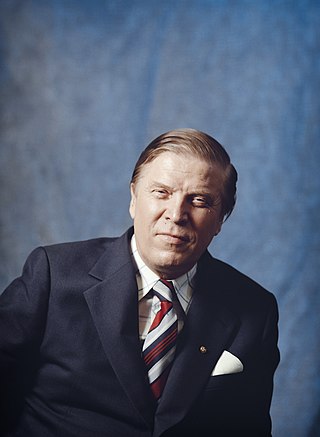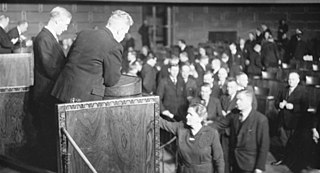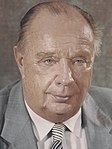
Urho Kaleva Kekkonen, often referred to by his initials UKK, was a Finnish politician who served as the eighth and longest-serving president of Finland from 1956 to 1982. He also served as prime minister, and held various other cabinet positions. He was the third and most recent president from the Agrarian League/Centre Party. Head of state for nearly 26 years, he dominated Finnish politics for 31 years overall. Holding a large amount of power, he won his later elections with little opposition and has often been classified as an autocrat.

The Centre Party, officially the Centre Party of Finland, is an agrarian-centrist political party in Finland. Ideologically, the Centre Party is positioned in the centre on the political spectrum. It has been described as liberal, social-liberal, liberal-conservative, and conservative-liberal. The party’s leader is Annika Saarikko, who was elected in September 2020 to follow Katri Kulmuni, the former finance minister of Finland. As of December 2019, the party has been a coalition partner in the Marin Cabinet, led by Prime Minister Sanna Marin of the Social Democratic Party (SDP).

Johannes Virolainen was a Finnish politician and who served as 30th Prime Minister of Finland, helped inhabitants of Karelia, opposed the use of alcohol and created Mandatory Swedish in Finnish basic schools.
Parliamentary elections were held in Finland on 6 and 7 July 1958. The communist Finnish People's Democratic League emerged as the largest party, but was unable to form a government.
Parliamentary elections were held in Finland on 1 and 2 July 1951.
Parliamentary elections were held in Finland on 7 and 8 March 1954.
Parliamentary elections were held in Finland on 4 and 5 February 1962.
Parliamentary elections were held in Finland on 15 and 16 March 1970.
Parliamentary elections were held in Finland on 2 and 3 January 1972.
Parliamentary elections were held in Finland on 21 and 22 September 1975.
Parliamentary elections were held in Finland on 18 and 19 March 1979.

Two-stage presidential elections were held in Finland in January 1982. The public elected presidential electors to an electoral college on 17 and 18 January. They in turn elected the president. The result was a victory for Mauno Koivisto, the first member of the Social Democratic Party to be elevated to the country's highest post, and his election meant the full integration of Social Democrats into Finnish public life and an end to the postwar dominance of the Centre Party.
Two-stage presidential elections were held in Finland in 1925. On 15 and 16 January the public elected presidential electors to an electoral college. They in turn elected the president. The result was a victory for Lauri Kristian Relander, who won on the third ballot. The turnout for the popular vote was just 39.7%. The outgoing president, K.J. Ståhlberg, had refused to seek a second term. According to the late Agrarian and Centrist politician, Johannes Virolainen, he stepped down after one term because he believed that an incumbent president would be too likely to win re-election. President Ståhlberg claimed that he had already completed his political service to Finland as president. Moreover, he wanted to step down because many right-wing Finns opposed him. According to Pentti Virrankoski, a Finnish historian, President Ståhlberg hoped that his retirement would advance parliamentary politics in Finland. Ståhlberg's party, the Progressives, chose Risto Ryti, the governor of the Bank of Finland, as their presidential candidate. The Agrarians only chose Lauri Kristian Relander as their presidential candidate in early February 1925. The National Coalitioners originally chose former Regent and Prime Minister Pehr Evind Svinhufvud as their presidential candidate, but before the presidential electors met, they replaced Svinhufvud with Hugo Suolahti, an academician working as the rector (principal) of the University of Helsinki. Relander surprised many politicians by defeating Ryti as a dark-horse presidential candidate, although he had served as the Speaker of the Finnish Parliament, and as Governor of the Province of Viipuri. Ståhlberg had quietly favoured Ryti as his successor, because he considered Ryti a principled and unselfish politician. He was disappointed with Relander's victory, and told one of his daughters that if he had known beforehand that Relander would be elected as his successor, he would have considered seeking a second term.

Two-stage presidential elections were held in Finland in 1931. On 15 and 16 January the public elected presidential electors to an electoral college. They in turn elected the President.The result was a victory for Pehr Evind Svinhufvud, who won on the third ballot by just two votes. The turnout for the popular vote was 47.3%.
Two-stage presidential elections were held in Finland in 1937. The first stage was on 15 and 16 January 1937 as the public selected 300 presidential electors to an electoral college.
Two-stage presidential elections were held in Finland in 1950, the first time the public had been involved in a presidential election since 1937 as three non-popular elections had taken place in 1940, 1943 and 1946. On 16 and 17 January the public elected presidential electors to an electoral college. They in turn elected the President. The result was a victory for Juho Kusti Paasikivi, who won on the first ballot. The turnout for the popular vote was 63.8%. President Paasikivi was at first reluctant to seek re-election, at least in regular presidential elections. He considered asking the Finnish Parliament to re-elect him through another emergency law. Former President Ståhlberg, who acted as his informal advisor, persuaded him to seek re-election through normal means when he bluntly told Paasikivi: "If the Finnish people would not bother to elect a President every six years, they truly would not deserve an independent and democratic republic." Paasikivi conducted a passive, "front-porch" style campaign, making few speeches. By contrast, the Agrarian presidential candidate, Urho Kekkonen, spoke in about 130 election meetings. The Communists claimed that Paasikivi had made mistakes in his foreign policy and had not truly pursued a peaceful and friendly foreign policy towards the Soviet Union. The Agrarians criticized Paasikivi more subtly and indirectly, referring to his advanced age, and speaking anecdotally about aged masters of farmhouses, who had not realized in time that they should have surrendered their houses' leadership to their sons. Kekkonen claimed that the incumbent Social Democratic minority government of Prime Minister K.A. Fagerholm had neglected the Finnish farmers and the unemployed. Kekkonen also championed a non-partisan democracy that would be neither a social democracy nor a people's democracy. The Communists hoped that their presidential candidate, former Prime Minister Mauno Pekkala, would draw votes away from the Social Democrats, because Pekkala was a former Social Democrat. The Agrarians lost over four per cent of their share of the vote compared to the 1948 parliamentary elections. This loss ensured Paasikivi's re-election. Otherwise Kekkonen could have been narrowly elected President - provided that all the Communist and People's Democratic presidential electors would also have voted for him.

Indirect presidential elections were held in Finland in 1946. In 1944 the Parliament had passed a law that enabled Carl Gustaf Emil Mannerheim to serve a six-year term. However, he resigned on 4 March 1946, giving as his reason his declining health and his view that the tasks he had been selected to carry out had been accomplished. An election was held in Parliament to appoint his successor. Juho Kusti Paasikivi was elected with 159 of the 200 votes. Mannerheim had suffered from poor health since 1945, and he had vacationed abroad from November 1945 to January 1946. He had been concerned about the possibility of being indicted for abusing his office as the Commander-in-Chief of the Finnish army when approving of Finland's participation in the Continuation War (1941–1944) against the Soviet Union, and in an informal military alliance with Germany. He was not indicted, but eight leading wartime Finnish politicians were, and Mannerheim stayed abroad, mainly in Portugal, and on sick leave in the Red Cross's hospital in Helsinki from November 1945 to March 1946, to remain on the political background during the "war guilt" trial. Paasikivi was regarded by many Finnish politicians as the only realistic successor of Mannerheim, given his long diplomatic and foreign policy experience. Because many Karelian refugees would not yet have been able to vote in regular Finnish presidential elections until the autumn of 1946, due to their frequent changes of home town, the Finnish Parliament decided to pass an exceptional law to elect the new President. Former President K.J. Ståhlberg was not an official presidential candidate, but he received 14 sympathy votes in these presidential elections, because a few Finnish parliamentarians respected his preference for regular presidential elections.

Two-stage presidential elections were held in Finland in 1956. On 16 and 17 January the public elected presidential electors to an electoral college. They in turn elected the President.
Two-stage presidential elections were held in Finland in 1962. On 15 and 16 January the public elected presidential electors to an electoral college. They in turn elected the President. The result was a victory for Urho Kekkonen, who won on the first ballot. The turnout for the popular vote was 81.5%.
Two-stage presidential elections were held in Finland in 1968. On 15 and 16 January the public elected presidential electors to an electoral college. They in turn elected the President. The result was a victory for Urho Kekkonen, who won on the first ballot. The turnout for the popular vote was 70%.










